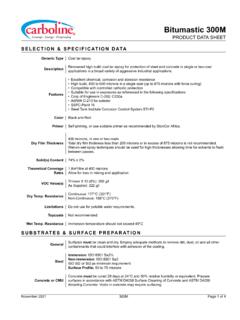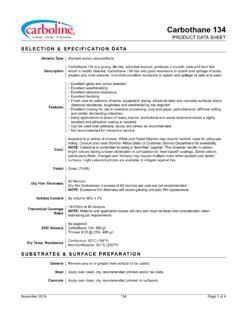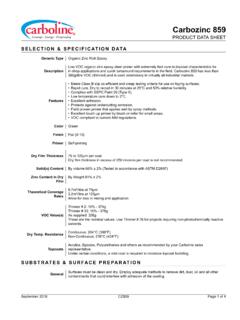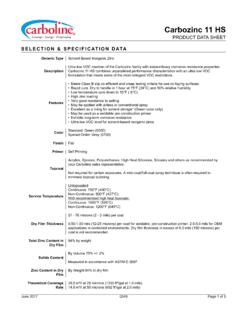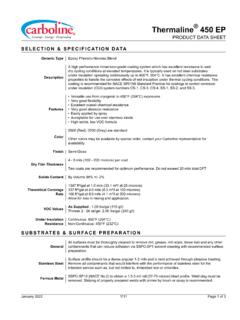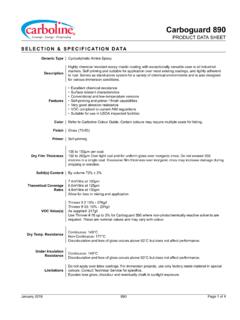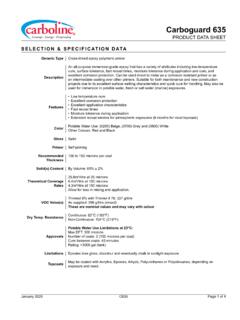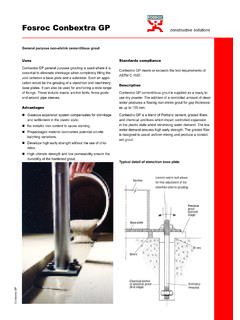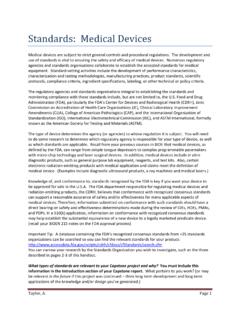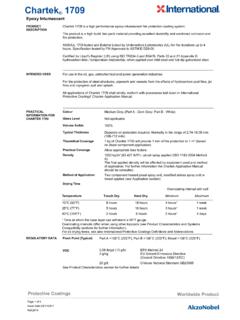Transcription of SELECTION & SPECIFICATION DATA - Carboline
1 Carbozinc 11 PRODUCT data SHEET November 20210250 Page 1 of 5 SELECTION & SPECIFICATION data Generic TypeSolvent Based Inorganic Zinc DescriptionTime-tested corrosion resistant primer that provides excellent corrosion protection to steel in someof the harshest environments. For over five decades, Carbozinc 11 has been the industry standardfor high-performance inorganic zinc protection on steel structures worldwide. Features Meets Class B slip co-efficient and creep testing criteria for use on faying surfaces Rapid cure.
2 Dry to handle in 45 minutes at 16 C (60 F) and 50% relative humidity. Low temperature cure down to -18 C High zinc loading Meets FDA requirements Zinc supplied meets ASTM D520 (Type II) Meets SSPC Paint 20 Type I, Level 1 for zinc content Complies with the composition and performance requirements of AS/NZS , Type 4 andAS "Single Coat Inorganic Zinc Silicate" Very good resistance to salting May be applied with standard airless or conventional spray equipment Approved for use in food & dairy processing plants (refer to "Approvals NZ/AU" section)
3 ColourGrey & Green FinishFlat PrimerSelf Priming Film Build50 - 75 microns dry Dry film thickness in excess of 150 microns is not recommended Solid(s) ContentBy Volume +/- 2% per ASTM D2697By Volume per Void Method Total Zinc Content inDry Film85% by weight Coverage m2/ litre at 75 microns DFT Allow for loss in mixing and application. VOC ValuesAs Supplied : 479 g/l per EPA Method 24 Maximum ServiceTemperatureUntopcoatedContinuous: 400 CNon-Continuous: 427 CWith recommended high heat topcoats:Continuous: 538 CNon-Continuous: 650 C TopcoatsCan be topcoated with Epoxies, Polyurethanes, Acrylics, High-Heat Silicones and others asrecommended by your Carboline sales representative.
4 Not required for certain exposures. Under certain conditions, a mist coat is required to minimizetopcoat 11 PRODUCT data SHEET November 20210250 Page 2 of 5 SUBSTRATES & SURFACE PREPARATION GeneralSurfaces must be clean and dry. Employ adequate methods to remove dirt, dust, oil and all othercontaminants that could interfere with adhesion of the coating. SteelMinimum standard of preparation in mild C1 to C3 environments is abrasive blast to SSPC-SP 6(AS Sa 2) and achieve a uniform jagged blast profile of 35 m (minimum) and up to 75 optimum performance and durability, and more aggressive environments, abrasive blast toSSPC-SP 10 (AS Sa 2 ) and achieve a uniform jagged blast profile of 35 m (minimum)and up to 75 data Test MethodSystemResultsAASHTO M300 Bullet HoleImmersion Paragraph ct.
5 CZ11 over Abrasive blasted steelNo blistering or rusting of coating orrusting of bare steel area after 650hrs. Immersion in 5% sodium chlorideASTM A-325 Slip Co-efficientBlasted Steel 1 ct. CZ 11@ 150 microns (6 mils) ; meets requirement for Class B ratingASTM B117 Salt Spray1 ct CZ11 at 2 mils dry filmthickness over blasted rusting blistering crackingdelamination after 43000 salting of the surface D3363 Pencil Hardness1 ct. CZ11 Pencil Hardness "2H" All test data was generated under laboratory conditions. Field testing results may & THINNING MixingPower mix base, then combine and power mix as follows.
6 Pour zinc filler very slowly into premixedbase with continuous agitation. Mix until free of lumps. Pour mixture through a 30 mesh zinc through a screen will aid in the mixing process by breaking up or catching dry zinclumps. DO NOT MIX PARTIAL KITS. ThinningMay be thinned up to 4% with Thinner #26 or #33 for ambient and warm surfaces. For extremelywarm or windy conditions (above 29 C) refer to Carboline Technical Service Group for cool weather (below 4 C), thin up to 6% with Thinner #21. Use of thinners other than those supplied or recommended by Carboline may adversely affectproduct performance and void product warranty, whether expressed or implied.
7 Ratio4 litre kit:Part A - 3 litresZinc Filler - 7 kg Pot Life8 Hours at 24 C and less at higher life ends when coating becomes too viscous to 11 PRODUCT data SHEET November 20210250 Page 3 of 5 APPLICATION EQUIPMENT guidelines Listed below are general equipment guidelines for the application of this product. Job site conditions may require modificationsto these guidelines to achieve the desired results. Spray Application(General)The following spray equipment has been found suitable and is available from equipmentmanufacturers.
8 Keep material under mild agitation during application. If spraying stops for morethan 10 minutes, recirculate the material remaining in the spray line. Do not leave mixed primer inthe hoses during work stoppages. Conventional SprayAgitated pressure pot equipped with dual regulators, mm (3/8 ) minimum material hose,with a maximum length of 50 feet; mm ( ) fluid tip and appropriate air cap. Airless SprayPump Ratio: 30:1 (min.)Output: 12 lts / minute (min.) material Hose: mm (3/8 ) (min.)Tip Size: Output PSI: 1500-2000 Filter Size: 60 meshPTFE packings are recommended and available from the pump manufacturer.
9 BrushFor touch-up of areas less than one square foot only. Use medium bristle brush and avoidrebrushing. RollerNot CONDITIONS ConditionMaterialSurfaceAmbientHumidityM inimum-18 C (-0 F)-18 C (-0 F)-18 C (-0 F)30%Maximum54 C (129 F)93 C (199 F)54 C (129 F)95% This product simply requires the substrate temperature to be above the dew point. Condensation due to substrate temperaturesbelow the dew point can cause flash rusting on prepared steel and interfere with proper adhesion to the substrate. Specialapplication techniques may be required above or below normal application 11 PRODUCT data SHEET November 20210250 Page 4 of 5 CURING SCHEDULE Surface to HandleDry to Recoat & Topcoatw/ other finishes-18 C (-0 F)4 Hours7 Days4 C (40 F)1 Hour48 Hours16 C (60 F)45 Minutes24 Hours27 C (80 F)45 Minutes18 Hours38 C (100 F)15 Minutes16 Hours These times are based on a 75-100 micron dry film thickness.
10 Higher film thickness, insufficient ventilation or cooler temperatureswill require longer cure times and could result in solvent entrapment and premature failure. Humidity levels below 50% will requirelonger cure : Maximum recoat time is unlimited. Must have a clean, dry surface free of chalk, zinc salts, etc per typical good paintingpractices. Consult Carboline Technical Service for specific information. Also, loose zinc must be removed from the cured film byrubbing with fiberglass screen wire if:1) The Carbozinc 11 is to be used without a topcoat in immersion service and "zinc pick up" could be detrimental, or2) When "dry spray/overspray" is evident on the cured film and a topcoat will be accelerated curing or where the relative humidity is below 40%, allow an initial 2-hour ambient cure.
